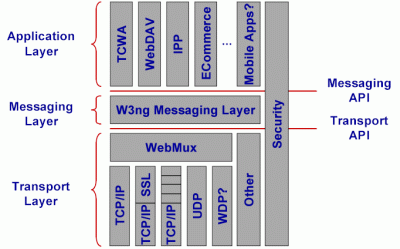W3C's work on HTTP Next Generation (HTTP-NG) is being managed as part of W3C's Architecture Domain.
Activity statements provide a managerial overview of W3C's work in this area. They provide information about what W3C is actively doing in a particular area and how we believe this will benefit the Web community. You will also be able to find a list of accomplishments to date and a summary of where we are headed. The area overview is often a good source of more generic information about the area and the background reading pages can help set the scene and explain any technical concepts in preparation.
The World Wide Web is a tremendous and growing success and HTTP has been at the core of this success as the primary substrate for exchanging information on the Web. However, HTTP/1.1 is becoming strained modularity wise as well as performance wise and those problems are to be addressed by HTTP-NG.
Modularity is an important kind of simplicity, and HTTP/1.x isn't very modular. If we look carefully at HTTP/1.x, we can see it addresses three layers of concerns, but in a way that does not cleanly separate those layers: message transport, general-purpose remote method invocation, and a particular set of methods historically focused on document processing (broadly construed to include things like forms processing and searching).
The lack of modularity makes the specification and evolution of HTTP more difficult than necessary and also causes problems for other applications. Applications are being layered on top of HTTP, and these applications are thus forced to include a lot of HTTP's design - whether this is technically ideal or not. Furthermore, to avoid some of the problems associated with layering on top of HTTP, other applications start by cloning a subset of HTTP and layering on top of that.
The HTTP-NG Activity is proposing a new architecture for the Web infrastructure based on a layered approach where HTTP is split up in layers as depicted in the diagram below:

The work on HTTP-NG was been done at W3C by Henrik Frystyk Nielsen, Jim Gettys and Daniel Veillard who work with other researchers from a number of companies and organizations. All the documents produced by the Protocol Design Group are already available as either W3C Technical Reports or IETF Internet Drafts.
At the IETF in Orlando, December 1998, we presented the initial work described in the Internet Draft " HTTP-NG Overview: Problem Statement, Requirements, and Solution Outline" along with the following IETF Internet Drafts:
While there was interest in the Project, the general feeling was that it was too early to bring it to IETF and that we needed to provide a plan for how to get where are today to where we would like to be. One of the arguments that we got was that people were just getting used to HTTP/1.1 and saw HTTP-NG as a 'warm-hole' into a very different Web infrastructure than what we have today.
Two results came out of this:
We espect that both of these tasks will take W3C efforts and so we plan to be asking the W3C Membership for additional resources during the spring of 1999.
By breaking down the HTTP-NG Activity into smaller more manageable pieces we expect to better be able to interact with other Activitites both in the W3C and in the IETF. We still believe that HTTP-NG is a significant step forward in the W3C's persue of realizing the full potential of the Web. There are today so many applications that we would like to see on the Web which either can not be implemented or simply are too complex to deploy in the current infrastructure. We hope to be able to change that!
Yves Lafon, W3C
Jim Gettys, Visiting Engineer - Compaq
Computer Corporation
Last modified $Date: 1999/10/20 16:04:28 $